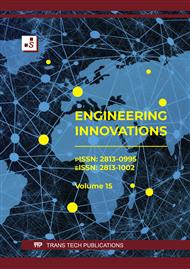[1]
Nazarova Nafisa Ilhomovna., "The Importance of role of Gears in Mechanical Engineering," in Proceedings of the Thirteenth EuroSys Conference, Porto Portugal: ACM, Apr. 2018, p.1–15
DOI: 10.1145/3190508.3190551
Google Scholar
[2]
J. A. Faria, E. Nunes, and M. A. Matos, "Cost and quality of service analysis of production systems based on the cumulative downtime," Int. J. Prod. Res., vol. 48, no. 6, p.1653–1684, Mar. 2010.
DOI: 10.1080/00207540802068631
Google Scholar
[3]
E. P. Carden and P. Fanning, "Vibration based condition monitoring: A review," 2004.
DOI: 10.1177/1475921704047500
Google Scholar
[4]
N. H. Chandra and A. S. Sekhar, "Fault detection in rotor bearing systems using time frequency techniques," Mech Syst Signal Process, vol. 72–73, p.105–133, May 2016.
DOI: 10.1016/j.ymssp.2015.11.013
Google Scholar
[5]
T. Praveenkumar, M. Saimurugan, P. Krishnakumar, and K. I. Ramachandran, "Fault diagnosis of automobile gearbox based on machine learning techniques," in Procedia Engineering, Elsevier Ltd, 2014, p.2092–2098.
DOI: 10.1016/j.proeng.2014.12.452
Google Scholar
[6]
Y. Bella, A. Oulmane, and M. Mostefai, "Industrial Bearing Fault Detection Using Time-Frequency Analysis," 2018. [Online]. Available: www.etasr.com
DOI: 10.48084/etasr.2135
Google Scholar
[7]
P. Ong, A. John Koshy, K. H. Lai, C. K. Sia, and M. Ismon, "A deep learning approach for health monitoring in rotating machineries using vibrations and thermal features," Decision Analytics Journal, vol. 10, Mar. 2024.
DOI: 10.1016/j.dajour.2024.100399
Google Scholar
[8]
M. Sohaib et al., "Gearbox fault diagnosis using improved feature representation and multitask learning," Front Energy Res, vol. 10, Sep. 2022.
DOI: 10.3389/fenrg.2022.998760
Google Scholar
[9]
H. Sindi, M. Nour, M. Rawa, Ş. Öztürk, and K. Polat, "A novel hybrid deep learning approach including combination of 1D power signals and 2D signal images for power quality disturbance classification," Expert Syst Appl, vol. 174, Jul. 2021.
DOI: 10.1016/j.eswa.2021.114785
Google Scholar
[10]
F. Tan, "Improving Feature Selection Techniques for Machine Learning Improving Feature Selection Techniques for Machine Learning Feng Tan".
Google Scholar
[11]
F. Tan, "Improving Feature Selection Techniques for Machine Learning Improving Feature Selection Techniques for Machine Learning Feng Tan".
Google Scholar
[12]
M. A. Khamis, W. Gomaa, and W. F. Ahmed, "Machine learning in computational docking," Mar. 01, 2015, Elsevier.
DOI: 10.1016/j.artmed.2015.02.002
Google Scholar
[13]
F. P. García Márquez, A. M. Tobias, J. M. Pinar Pérez, and M. Papaelias, "Condition monitoring of wind turbines: Techniques and methods," Renew Energy, vol. 46, p.169–178, Oct. 2012.
DOI: 10.1016/j.renene.2012.03.003
Google Scholar
[14]
P. Nunes, J. Santos, and E. Rocha, "Challenges in predictive maintenance – A review," Feb. 01, 2023, Elsevier Ltd.
DOI: 10.1016/j.cirpj.2022.11.004
Google Scholar
[15]
H. Bhavsar and A. Ganatra, "A Comparative Study of Training Algorithms for Supervised Machine Learning," vol. 2, no. 4, 2012.
Google Scholar
[16]
L. Lévesque, "Revisiting the Nyquist criterion and aliasing in data analysis," Eur. J. Phys., vol. 22, no. 2, p.127–132, Mar. 2001.
DOI: 10.1088/0143-0807/22/2/304
Google Scholar
[17]
Y. Yu et al., "Dynamic control flow in large-scale machine learning," in Proceedings of the Thirteenth EuroSys Conference, Porto Portugal: ACM, Apr. 2018, p.1–15.
DOI: 10.1145/3190508.3190551
Google Scholar
[18]
I.O. Muraina, "Ideal Dataset Splitting Ratios in Machine Learning Algorithms: General Concerns for Data Scientists and Data Analysts".
Google Scholar
[19]
C. Schaffer and S. A. H. C. Edu, "Selecting a Classification Method by Cross-Validation," 1993.
Google Scholar
[20]
B. Al‐Najjar, "Impact of real‐time measurements of operating conditions on effectiveness and accuracy of vibration‐based maintenance policy ‐ A case study in paper mill," J. Qual. Maint. Eng., vol. 6, no. 4, p.275–287, Dec. 2000.
DOI: 10.1108/13552510010346815
Google Scholar
[21]
A. A. Rasheed, "Improving prediction efficiency by revolutionary machine learning models," Mater. Today Proc., vol. 81, p.577–583, 2023.
DOI: 10.1016/j.matpr.2021.04.014
Google Scholar


